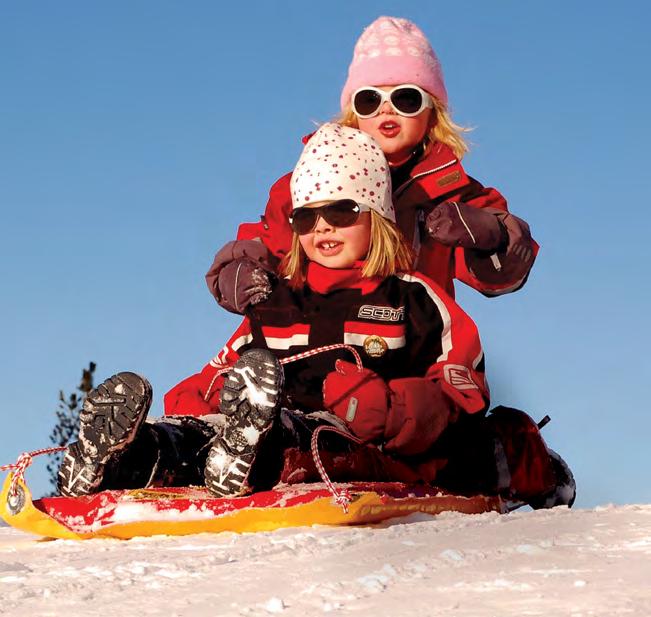

20/
36/
JANUARY 2023 | PARENTMAP.COM Wellness Resolutions Expert advice for charting your family’s well-being in the new year SEATTLE CHILDREN’S Good Growing Newsletter P. 27 PNW INSIDE + OUT
Ecotherapy for Mental Health How a focus on nature is changing therapy for kids
Nature Is the Best Teacher Local preschools offer joyful learning in the great outdoors
of your adjusted gross income, whichever is less.



Families making up to qualify. Find out if you qualify at: samisfoundation.org/eligibility-estimator
Jewish day school of your choice.

Get an exceptional, private, Jewish day school education for less than you ever imagined.
AFFORDABILITY DAY SCHOOL INITIATIVE
Feature
A Year of New Beginnings 10
Never fear if the things you resolve to do tend to dissolve by Jan. 15
Parenting
WELLNESS
Mindfulness Skills to Help Navigate Low Moments 6 Self-soothing coping techniques for anyone, anywhere, at any time

Ecotherapy for Mental Health 20 How a focus on nature is changing therapy for kids 9 Immunity-Boosting Foods to Feed Your Family 26 Healthy recipes with superfood ingredients that kids will love 6 Clever Ideas to Get Kids to Eat Their Vegetables 31 Fill their plates with ‘X-ray vision carrots’ and other exciting veggies
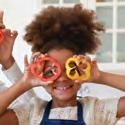
Mammogram Callbacks 45 Here’s what you should know if you’re on the receiving end of such a call
How Breast Milk and Formula Impact Baby Teeth 54 Preventive steps to keep your family’s smallest smiles healthy
BIRTHDAYS
Ixnay the Plastic Party Favor Junk 8 Ditch the waste and keep the fun with these creative ideas

Local Resources Birthdays 8 Camps, Arts + Activities 24 Schools + Preschools 36 Pediatric Dentists 54
EDUCATION
Nature Is the Best Teacher 38 Local preschools offer joyful learning in the great outdoors
AGES + STAGES
Sleepover Guidelines That All Parents Should Know 49 Keep these important tips in mind for your kid’s next sleepover

REPAIR THE WORLD What Happens in the Classroom Can Happen in Society 52 ‘In a democratic nation, incarceration should be a last resort’
Family Fun
OUT + ABOUT January Play List 34 Plunge into 2023 with 15 ways to find fun and meaning with your fam
New year, part deux: We’ve rounded up a year’s worth of new beginnings, if your New Year’s resolutions falter.

January 2023
CONTENTS
PARENTMAP.COM
Every Issue Dear Reader 4 Play List 34
4 Crafty Nature Activities to Promote ‘Ecohappiness’ 23 Bundle up and head out to connect with nature in its quiet season
In
34 31
p. 20 10 16 49
PARENTMAP / JANUARY 2023 / 3
“A growing number of studies indicate that exposure to nature benefits kids in different ways, such as by lowering stress and promoting better cognitive development.”
Correction: In the article “Let the Holidays ‘Show’ Your Family a Good Time” in the December 2022 print issue of ParentMap magazine, the photo by Rex Tranter of the International Ballet Theatre’s production of “The Nutcracker” (displayed on p. 13) was erroneously credited to Pacific Northwest Ballet.
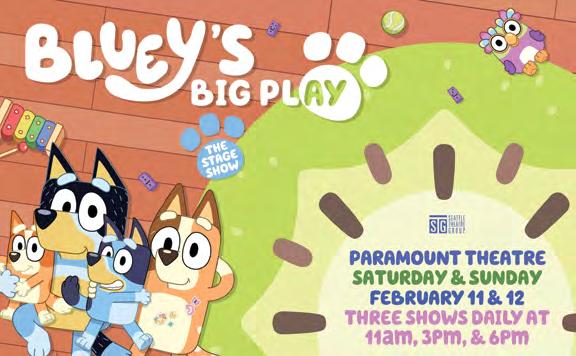





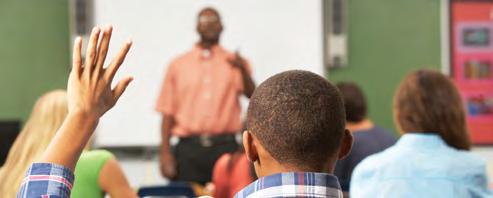





PARENTMAP /JANUARY 2023 / 5 PRESENTING SPONSOR GOLD SPONSORS With Khalil Gibran Muhammad, Ph.D., and Jeffery Robinson Register now: ParentMap.com/live Past Forward: The Legacy of Racism in Modern-Day America FREE Webinar PLATINUM EVENT PARTNER Thursday, Jan. 19 | 1–2 p.m. PT
Wellness
Mindfulness Skills to Help Navigate Low Moments
By Sarah Skoterro, LPCC, LADAC
Dialectical behavior therapy (DBT; dialecticalbehaviortherapy.com) focuses on four major components: interpersonal effectiveness, mindfulness, emotional regulation and distress tolerance. Self-soothing DBT mindfulness techniques can help you manage anxious, depressive, obsessive or intrusive thoughts. These coping skills can be used by anyone, anywhere and at any time.
What is mindfulness?
In a psychological context, mindfulness is defined as “nonjudgmental attention to the present moment.” Rooted in concepts of meditation, the practice of mindfulness aims to promote intention, reflection, compassion and a nonjudgmental approach toward emotions.
So, what does that have to do with coping with sadness, anger, impulsiveness or frustration, and emotional regulation? Everything, actually.
Putting DBT skills to use increases our ability to regulate emotions with proven techniques for de-escalation and coping. In mindfulness, we’re offered the time and space to feel and reflect on our emotions consciously instead of subconsciously. This allows us to understand our emotions better and act on them while pressing pause on our impulses.
Core facets of DBT mindfulness: ‘What’ and ‘how’ skills
DBT is divided into four skills categories, each of which addresses a core facet of a “life worth living”; these include emotional regulation, interpersonal effectiveness, distress tolerance and mindfulness. The four DBT skills categories are further broken down into digestible skills that can be easily understood and implemented in daily life.
Mindfulness skills — the “what” skills, in particular — are rooted in the actionable steps of observing internal and external states, describing the present experience and participating fully in the present moment. DBT “how” skills complement the “what” skills perfectly, teaching us to engage in each moment nonjudgmentally, mindfully and effectively (or choosing to do what works).
‘What’ skills: Observing your thoughts and simply paying attention to your experience can help you better label the emotion, gauge the strength and duration of the feeling, and later, help overcome the grip of strong — sometimes painful — emotions, such as anxiety or sadness. Next, describing your feelings is important in helping you recognize what environmental (or internal) events cue certain emotions
and how exactly they make you feel; the act of describing can assist with identifying the exact emotion you are feeling in regard to the precipitating event. This is best described with the example of “I” statements, e.g., “I feel disappoint ed when I …” instead of “I am a disappointment.”
When we participate fully in the moment, we are operating counterculturally and immersing ourselves fully in the task before us. This skill rejects the idea of multitasking and asks us to become absorbed fully into the one thing that we are doing.
‘How’ skills:
The first DBT “how” skill requires a nonjudgmental awareness of the present moment. Mastering this ability to perceive without emotionally reacting (no matter if the present moment is experienced as being positive or negative) helps us to interpret and label our feelings accurately to gauge an appropriate, thoughtful response. Often when we act on emotions alone, our reactions are fueled by an immediate impassioned reflex, which can lead to overreacting, impulsive behavior and emotionally charged decision-making. Even positive judgments are not always helpful to us, and this component of nonjudgmental awareness asks us to refrain from engaging the part of us that wants to categorize feelings and experiences in terms of “good” and “bad.”
The second “how” skill that suggests we engage in life onemindfully is reminiscent of the “what” skill of participating fully. Whether we are watching our favorite show on Netflix or eating dinner, these skills ask us to resist the urge to also scroll on our phone or multitask while we move throughout our day.
Finally, choosing to lean into effectiveness and do what works allows us to tailor our approach to life and these skills based on our personal preferences. This skill affirms our individuality and empowers us to make decisions that are best for us. In building DBT mindfulness skills, we’re encouraged to act according to what’s proven to be helpful for us — and leave the rest behind.
Practicing mindfulness encompasses the rituals of “what” and “how” skills to create an awareness of emotions in the present moment. Such awareness of our emotions is the first step toward better control and verbalization of those feelings.

DIY DBT mindfulness exercises
Having a better understanding of DBT and its core facets sets an important foundation for effectively and successfully utilizing mindfulness exercises.
Walking meditation
This practice allows us to turn off our autopilot setting. Instead, we can use the walk to quiet our minds. When walking, instead of thinking of work or your to-do list, focus only on your surround-
6 / PARENTMAP.COM
ings: your feet meeting the ground, sounds, smells, the sensation of a breeze. Given that mindfulness is rooted in the present moment, this is a very simple way to change your surroundings and practice observing and describing sensations.

5-finger hand trace





This exercise can be done virtually anywhere. Put your hand in front of you and spread your fingers. With your other hand and starting at your thumb, trace your finger from your palm to the tip while inhaling, and then back from the tip to the base while exhaling. This helps to regulate breathing, focus on movement, and build that mindbody connection and awareness.
Body scan
This exercise trains you to focus on isolated parts of your body and sensations, starting from your head, down to your toes, in five-minute increments. This practice allows you to cultivate intentional emotional regulation and focus on the present moment. (You’ll find a video that demonstrates this meditation technique at dialecticalbehaviortherapy.com/mental-body-scan.)
Breathing exercises







One common mindfulness breathing exercise is diaphragmatic breathing. While seated in a relaxed and comfortable position, place your hand on your lower stomach. Focus on breathing with your diaphragm by watching the hand placed on your lower abdomen rise and fall for about 10 minutes. This focus on deep breathing increases the mind-body connection while redirecting your mind from outside thoughts.
With this knowledge, you can practice these mindfulness techniques to help you navigate moments of low, negative emotions.



Though DBT mindfulness exercises can be helpful to add to your repertoire of healthy coping and self-soothing skills, a professional can guide you in applying DBT skills to your individual needs and support your development and understanding of dialectical behavior therapy and mindfulness.

■












 Sarah Skoterro, LPCC, LADAC, is a clinical therapist and director of business development at Bellevue-based THIRA Health (thirahealth.com),
Sponsored by
Sarah Skoterro, LPCC, LADAC, is a clinical therapist and director of business development at Bellevue-based THIRA Health (thirahealth.com),
Sponsored by
The mission of THIRA Health is to support women and girls living with mood disorders by using comprehensive approaches that address the whole self, along with an emphasis on community support. This is made possible by a team of trained, certified experts skilled in using dialectical behavioral therapy, art and movement therapies, nutrition and more. PARENTMAP / JANUARY 2023 / 7
Ixnay the Plastic Party Favor Junk
Ditch the waste and keep the fun with these creative ideas

 By JiaYing Grygiel
By JiaYing Grygiel
Birthday parties are back with a vengeance after a more than two-year pandemic hiatus. Yes, it’s great seeing our friends again and celebrating milestones together, but tell me a tiny part of you doesn’t miss relaxed, carefree weekends not spent racing to back-to-back birthday parties. Plus: All. The. Tiny. Plastic. Things!
I’m talking about goody bags, those little sleeves of swag that kids emerge from parties with, clutching them in their sweaty fists, their faces smeared with pizza sauce and looking slightly dazed after spending two hours in close quarters with 20 screaming peers.
Don’t get me wrong, I’m 100 percent guilty of handing out goody bags, too. Kids love them. And childhood is fleeting, so why not let them have a little bit of joy? I’m all for joy, as long as I’m not constantly picking up joy or stepping on joy.
We’re all smart people. Let’s do the right thing for the planet — and for our sanity.
Skip the goody bag.
It sounds extreme, but hear me out. Kids don’t actually notice when there’s no goody bag unless you point it out. They’re too hopped up on ice cream and cake, and focused on friends, which is the whole point of a party.
Really, can we parents band together as a collective whole and agree to ixnay this one out-of-control tradition? It’s the bane of existence for every being who picks stuff up from off of the floor:
moms, dads, caregivers, pets — and little siblings who stuff choking hazards in their mouths.
Make it consumable.
Not comfortable quitting cold turkey? At least make your goody bag something consumable, not a further contribution to populating the planet with bits of throwaway plastic from the Dollar Store.
You can give something that always gets used up; for instance, sidewalk chalk or sticky notes.

Or something edible, as long as you make it junky and as nonnutritious as possible.
Or packets of seeds, which really give something back to the planet, in addition to providing a bonus science lesson.
Or a book. “We have too many books,” says no parent ever
Or vinyl stickers, so kids can personalize and clearly identify their own water bottle.

Or incorporate a craft activity into your party, so the kids make an art project and take their original masterpiece home.
Regift it.
Even if you scrap the goody bag, chances are your kid is going to come home with some treasures anyway. Kids do love swag. But the joy is short-lived. The thrill is in opening a surprise, and it takes about a nanosecond before they’ve moved on.
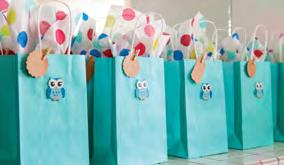
Here’s my solution/confession: Every year, hundreds of small children come to my door seeking a handout. It’s called Halloween — you may have heard of it?
I save goody-bag trinkets all year and regift them to trick-ortreaters. It’s actually a thing, putting out a teal pumpkin to signal that you have non-candy treats for kids with food allergies. Kids get a fun little prize, I get stuff out of my house. It’s a win-win.
I know I’m just handing off the problem, but at least that little piece of plastic goes through another round of enjoyment before it hits the landfill.
JiaYing Grygiel is a mama of two boys, and a freelance photographer and writer. She blogs at photoj.net.
LOCAL RESOURCES / BIRTHDAYS
■ 8 / PARENTMAP.COM

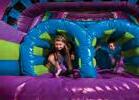







LOCAL RESOURCES / BIRTHDAYS KIRKLAND LYNNWOOD 425.820.2297 pumpitupparty.com/kirkland-wa 425.774.2297 pumpitupparty.com/lynnwood-wa Family Fun Calendar Find your adventure today! Our online calendar is your go-to guide for family activities around Puget Sound. ParentMap.com/calendar PARENTMAP / JANUARY 2023 / 9

miss the new year rush. But if you’re hankering for a new beginning in May, there are some creative options. May is Creative Beginnings Month, so feel free to freelance your own new year tradition to celebrate in May.
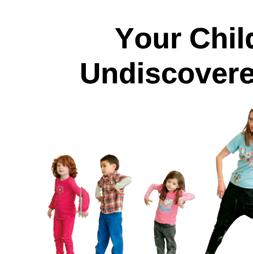
June


Andean New Year
Here in Seattle, June 21 marks the summer solstice, a celebration of the longest day of the year. But in South America, June 21 is the winter solstice. The Aymara people of Bolivia celebrate the longest night of the year with a vigil until the new day brings the beginning of a new year. In Peru, a reenactment of the Incan Festival of the Sun, Inti Raymi, is held around the time of the solstice.
July
Muharram
Muharram begins after the sighting of the new moon on the final

day of the Islamic lunar Hijri calendar. In 2023, it will start on the evening of July 18 and end at sundown on Aug. 17. The entire month is deeply holy, but the actual beginning of the year is generally of less importance than the 10th day, Ashura, when some people observe mourning rituals commemorating the death of the Prophet Muhammad’s grandson, Hussein ibn Ali. Solemn days of fasting and prayer are more widespread, with fasts broken by sweet foods and family gatherings.
August

Bérchules New Year
It looks as though the only place where the new year is routinely celebrated in August is in the small town of Bérchules in Andalusia, Spain. On New Year’s Eve in 1994, a power outage left the entire town all dressed up with no place to go. At a town meeting a few weeks later, citizens vented their anger at the electric company;
PARENTMAP / JANUARY 2023 / 13
Celebrate the Year of the Rabbit!
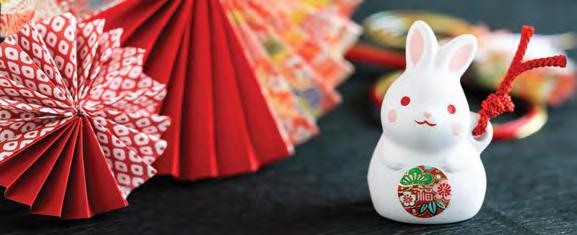 By Patty Lindley
By Patty Lindley
Lunar New Year begins on Jan. 22, and children born during this year will be under the sign of the Rabbit. As the sign representing longevity in Chinese mythology, the Rabbit is considered a most providential nativity: The Rabbit child is graced with good fortune and an assurance of happiness in life. If you’re expecting a little Rabbit, congratulations! Kiddos born under the sign of the Rabbit are said to be kind, artistic, graceful, self-assured and intelligent. Read on to learn more about the many standout qualities of your wee Rabbit.
About the Rabbit Child
So sweet their disposition, so even-tempered and obedient their comportment! Angelic Rabbit children are those miraculous tots who can sit quietly in restaurants with adults and occupy themselves with books and toys for hours on end — the kind of unicorn-rare children other parents envy! You will get credit you don’t even deserve for your parenting skills by virtue of your little Rabbit’s precociously decorous qualities.
Ah, but there is a more subterranean factor at work in this child! Adept at masking feelings and intentions, the Rabbit has a keen sense of what adults expect to hear, and deftly and diplomatically maneuvers parents into conforming to their agenda. These children typically get their way, but through subtle navigation, not florid, unseemly displays other children employ to prevail (waterworks,
hunger strikes, screaming fits, holding their breath, pitting mom against dad, etc.). Attuned to your personality makeup, they will artfully manipulate the family dynamics (sadly and typically via your weaknesses and blind spots) to engineer the outcome they prefer. And when such tactics backfire and your reprimands rain down on them, they’ll adroitly shed the fallout with a philosophical umbrella of indifference.
Helpful and obedient at home, conforming and well-mannered at school, the Rabbit child will never embarrass or outrage you. In fact, you can rest assured that they will represent the family beautifully in the outside world and will be well-liked in whatever sphere they inhabit. Public poise can transform into fretfulness and sullenness in the privacy of home occasionally, and the Rabbit child can experience sleep disturbances due to moods and illness.
Natural gifts
The Rabbit is the very soul of graciousness, possessing royal manners and a natural sense of discretion. They fall back on civility in all interactions, and are natural-born diplomats in any profession they choose. Rabbits tend to have sharp business acumen, and are ensured success and luck in attracting and managing wealth. The definition of decency and amiability in their dealings with others, the Rabbit’s inscrutability masks a very methodical and discerning knack for getting exactly what they want.
Making friends
There will be no obstacles to your Rabbit child making friends and influencing people, as they are by nature congenial and peace-loving. Guided emotionally and artistically, they have an attunement in friendship that is warm, if slightly detached. Best bets: Sheep
JUST FOR FUN 16 / PARENTMAP.COM
share the Rabbit’s appreciation for good taste and love of material comforts. Allergic to cloying emotional demands and brutish behavior, the Rabbit finds peaceable companionship with the loyal Dog and the honest Pig. They’ll be less a fan of the vainglorious, critical Rooster and will be averse to the showy, self-involved dramatics of the Tiger.
Learning
Amenable to classroom disciplinary policies, the Rabbit child is a dutiful and attentive student who will have the focus and native facility to learn easily. With a natural aptitude for examination and seeing all sides of an issue clearly, the Rabbit makes an effective and intelligent debater, even at a young age. Their accordance with good manners and diplomacy make them a classroom favorite with peers and teachers alike.
The Rabbit’s thoroughness confirms their standing as a good scholar, and they may go on to achieve success in advanced academic settings, seeking the types of disciplines (law, as a great example) that will ensure a comfortable and secure existence.
Parenting the Rabbit child
Miss/Mr. Congeniality: Rabbits choose to lead a tranquil life and will create and maintain a peaceful and congenial atmosphere. Well-mannered from babyhood, the Rabbit finds “scenes” and heavy emotional demands abhorrent. As a parent, keep in mind how your comportment and management of the household support your child’s sensibilities and requirement for serenity.
Help create a steppingstone from of a stumbling block: The Rabbit, by nature, puts their needs first and is attuned to the acquisition and preservation of their personal creature comforts. Watch out for a tendency in them to be overly materialistic as they grow up; also, help them cultivate a more generous perspective with respect to the needs of others, especially when those needs don’t necessarily align with their own, or may even compete with their own.
Learn more about your family’s Chinese zodiac signs at parentmap.com/zodiac.

Patty Lindley is the managing editor of ParentMap and a total geek for astrology.
In-Person & Virtual School Group Tours

topics including: Design Thinking Gender Equality Fighting Diseases And more! Book now for your class or group’s visit at Discovergates.org
Free
Explore
Always
■
PARENTMAP / JANUARY 2023 / 17
Presenting Sponsor:
Khalil Gibran Muhammad, Ph.D., and Jeffery Robinson
Jan. 19, 2023
Past Forward: The Legacy of Racism in Modern-Day America
Author and researcher Pepper Schwartz, Ph.D. Feb. 7, 2023
Modeling a Loving, Equal Partnership for Your Kids
Bestselling author Edward Hallowell, M.D., Ed.D. March 2, 2023


The Shifting ADHD/ADD Lens: Moving From Disability to Ability
Cultural researcher Jessica Joelle Alexander March 22, 2023

The Danish Way: Insights Into International Parenting
Sociologist and author Christine Carter, Ph.D. April 18, 2023

The Habits of Highly Effective Adolescents

Trauma specialist Laura van Dernoot Lipsky May 4, 2023
Transforming Trauma and Navigating Overwhelm June speaker to be announced




Special bonus! If you purchase a series ticket, you will receive a copy of “The Awakened Brain” by Lisa Miller, Ph.D.
Platinum Event Partner:



Registration is free and gains you access to the entire series: ParentMap.com/live Sign up for the 2022-2023 series
Join ParentMap online to hear from experts on timely issues affecting families, educators and caregivers, and get top tips to add to your parenting toolkit. Attendees of the March 22 event will be eligible to win a SNOO Smart Sleeper Bassinet (valued at $1,695) or a $500 Happiest Baby gift card, courtesy of Happiest Baby. Attendees will also be eligible to win a $100 Amazon gift card after each ParentEd talk.
Keep

your
family safe and healthy Scan the QR code below to sign up for Seattle Children’s Good Growing e-newsletter. Each issue shares timely tips to keep your family as safe and healthy as they can be.
Hope.
Care. Cure.™ Seattle Children’s is proud to be the presenting sponsor of the 2022–2023 ParentEd Talks series
Radhika, patient at Seattle Children’s
This flexibility in choosing a natural environment is a key benefit of ecotherapy, because in-office settings can feel intimidating, especially to kids. There’s a power differential between clinicians and clients, Lajiness says, so children attending therapy may feel as if “I’m the patient. There’s something wrong with me.” By contrast, when sessions take place in a park or while strolling along a beach, “the setting is just so helpful to create a sense of comfort and openness.”
Lajiness says demand for mental health services has increased over the past couple of years in response to the pandemic, with the stress of online school and the curtailment of regular activities hitting tweens and teens particularly hard. She has noticed a big uptick in anxiety and attention disorders among older elementary school and younger middle school students.
world is changing. Ecotherapy can help, both from a psychological and practical standpoint. “We have to prepare kids to live and survive and do well in a world that doesn’t even exist yet, but that is rapidly coming,” says Buzzell.
Buzzell cheered when I told her about my family’s attempts to grow tomatoes in our backyard. Learning simple survival skills, such as growing your own food, is an important aspect of ecotherapy, she says. “It gives kids a sense of empowerment.”
Interested in exploring ecotherapy with children? Here’s what experts suggest.
How to start
Identify your kids’ preferred connection to nature. Part of an ecotherapist’s job is learning how each person relates best to nature. “It’s not one size fits all,” Buzzell says. Although some children love playing outdoors, others enjoy creating nature art or listening to the rain. My youngest child isn’t a big fan of nature walks, but she loves turtles, so animals are her gateway to nature.
Use what is nearby.
Green space may not be easily accessible where you live. But kids don’t need to be sitting in a forest to connect with nature. Activities such as tending to a houseplant or caring for a pet fish offer their own benefits in emotional regulation, Lajiness says. Even a cut flower can offer a way to interact and observe nature.
Show kids how tech can bring them closer to nature.
Ecotherapy can help with these challenges. Exposure to nature tends to soothe and refresh overstimulated brains. While concrete tasks such as completing an assignment or writing an email require sustained, focused concentration, actions such as looking at a flower or listening to a thunderstorm cause us to engage in something called “soft fascination,” Lajiness says. “There isn’t necessarily the structure or the demand on our attention in a way that’s draining.”
Ecotherapy activities often start out as human-focused — or Level 1 ecotherapy, according to Linda Buzzell, a Santa Barbara, California, ecotherapist, psychotherapist and editor of the book “Ecotherapy: Healing With Nature in Mind.” Examples include playing in a garden or petting a friendly animal. Ideally, “as we engage with the rest of nature, we also begin to get the message that we need to pay attention to the health of Mother Nature as well as our own,” says Buzzell. This helps kids move to Level 2 ecotherapy, in which they actively care for nature, perhaps by tending a garden with an eye toward sustainability.
Due to extreme weather events fueled by climate change, many kids are feeling anxiety and sadness about how the
Vernon Hutter, an ecotherapist based in Devon, England, noticed how devices distracted kids from the natural world, so he encouraged his teenage daughter to use her smartphone mindfully by snapping photos of nature each day and sending them to him. Hutter recommends taking contrasting photos — first something big, such as clouds or a sunset; then something small, such as an insect. This intentionality helps foster awareness of the present moment.
Try nature-specific meditation.
Sandi Schwartz, author of the book “Finding Ecohappiness: Fun Nature Activities to Help Your Kids Feel Happier and Calmer,” suggests compassion meditation, during which children direct kind thoughts
A growing number of studies indicate that exposure to nature benefits kids in different ways, such as by lowering stress and promoting better cognitive development.
PARENTMAP / JANUARY 2023 / 21
4 Crafty Nature Activities to Promote ‘Ecohappiness’
 By Lauren Braden
By Lauren Braden
Do most birds fly south for the winter? How do leaves turn different colors? Why is each snowflake unique? If you know a little naturalist who wonders about such things, bundle them up head to toe in layers, fill a thermos with hot chocolate for frequent warm-up breaks and head out to connect with nature in its quiet season.
Sketch and paint an animal.
Pack up some pencils, sketch pads, paintbrushes and a watercolor palette, then head to a nearby wetland or forest to spot wildlife.
You may have to sit still for a while before you notice a bird, squirrel, deer or other animal to sketch. It’s a good idea to snap a digital photo of your animal in case it scurries away too soon. Using small, tentative pencil strokes instead of unbroken lines helps create energy and gives a sense of movement and life to your animal. Bring more life to the sketch with a finish of watercolor paint for both the animal and its surrounding landscape.
For inspiration and instruction, look for books by Molly Hashimoto, a Seattle artist who teaches connections with nature by observing, sketching or painting it. Her latest works include “Trees of the West: An Artist’s Guide” and “Birds of the West: An Artist’s Guide.”
LOCAL RESOURCES / CAMPS + ACTIVITIES PARENTMAP / JANUARY 2023 / 23

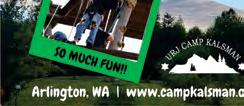














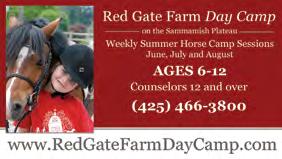
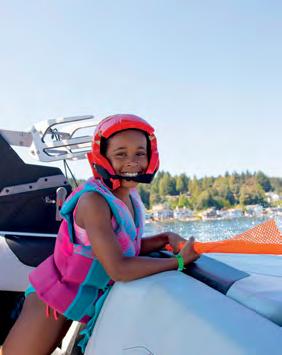







Familymusicclassesforchildrenages birththroughage8andthegrownupswholovethem! sunshinemusictogether.com Registration SRegistration ummer 2023 Summer 2023 NOW OPEN! NOW OPEN! sambica.com/camps sambica.com/camps PARENTMAP / JANUARY 2023 / 25
Healthy Coping Skills for the New Year
e new year is a great time to recommit to healthy habits — and try some new ones! is year, in addition to focusing on physical health, your family might want to set some goals to boost your mental and emotional wellbeing. Here are some ideas to get you started.
Acknowledge and name feelings. By identifying the emotions we’re experiencing, we can take a step back and examine what’s going on inside.
Search online for ‘feelings wheels’ and ‘emotion charts.’ ese colorful, printable tools can help us unpack and understand complex feelings.
Validate feelings for one another. Validation is a tool that shows your child (or anyone) that you understand and accept their thoughts and feelings. It requires sitting quietly and listening intently — without expressing any judgment or trying to ‘ x’ them.

Learn relaxation techniques. Explore some
simple breathing exercises and meditation techniques designed to calm and center you. Start by trying a few free, highly rated apps. Replace negative self-talk with a rmations. Pay attention to the messages running through your mind. Sometimes, we need to override them with positive self-talk — encouraging, empowering messages of self-acceptance.
Know your emotional triggers. By paying careful attention and learning exactly what can set us o , we can recognize triggering events when they happen, and not automatically react.
Let go of perfection. Perfect really is the enemy of good. Striving for perfection can paralyze us and make it impossible to complete a task or reach a goal. It can also alienate others. Commit to realistic expectations and embrace being fully human!
Break big tasks down into smaller tasks. Especially when you feel overwhelmed, remember that consistent ‘baby steps’ can get you to your goal surprisingly quickly.
Attend to your physical health. Building strong coping skills requires investing in your physical health. Be sure you’re eating nutritious foods, moving your body and getting enough sleep.
Remember what’s helped you cope in the past. When you’re going through a tough time, think back to recall what’s been helpful (and not helpful!) when you’ve been in similar situations.
Get More Health and Safety News
Sign up for the free Good Growing email newsletter and you will receive timely health and safety information six times each year. e format is easy to scan so you can quickly choose the information you need.




And of course, developing healthy coping skills requires some help. We all need to build a community of supporters we can count on. Faithful friends, trusted family members, wise counselors and expert healthcare professionals can all help us on this journey.
TO LEARN MORE: Visit seattlechildrens.org/mental-healthresources
A Seattle Children’s Publication | Winter 2023
Does your family make time for active play every day?
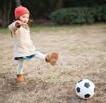
Even when it’s cold or wet, dress for the weather and head outside. Enjoy fresh air fun plus active time inside, whether it’s at home or a community center. Preschoolers need plenty of active play: aim for at least two hours each day. Ideally, preschoolers should play for about 15 minutes every hour. Provide active toys like balls, wagons, tricycles and balance bikes. Grade-school age kids and teens need
What is RSV?
What is RSV?

Respiratory syncytial virus (RSV) infects almost all children at least once before they are 2 years old. For most children it’s like a cold with a runny nose, sore throat and/or fever. But some children with RSV develop bronchiolitis or pneumonia and end up needing care in a hospital due to breathing problems. Children who are more likely to develop severe RSV infections include premature babies under 6 months of age, children with chronic lung or heart disease, and those with immune de ciencies. RSV is most common between November and April, and it’s very contagious. To prevent RSV, avoid crowds and
to be active at least 60 minutes each day, even if it’s broken into short segments of 10 or 15 minutes. Go for a variety of age-appropriate aerobic and muscle-strengthening activities. Join the action whenever you can!
TO LEARN MORE: Visit seattlechildrens.org/health-safety/keeping-kidshealthy/development/exercise
close contact with others who have cold symptoms. Be sure everyone in your family washes their hands frequently. Cover your mouth and nose when sneezing or coughing. row away used tissues right away, then wash your hands. If your baby or child has more serious RSV symptoms such as dehydration, a change in breathing or di culty breathing, see your healthcare provider right away.

TO LEARN MORE: Visit pulse.seattlechildrens.org/what-parentsshould-know-about-rsv
School Lockdown Drills Can Cause Anxiety
For most parents and caregivers, school safety concerns are di erent now from when they were in school. Today, lockdown drills are necessary to help keep kids safe at school. But these drills can spark fear and worry for kids and teens. It’s important to support your child through any anxiety they have related to lockdown drills and school violence. is is best done with reassuring conversations.
Be sure your child knows that lockdown drills will happen during the school year, because their teachers and sta want to make the school a safe place. Drills ensure that children know exactly what to do to help them stay safe in an emergency. Explain that these drills are safety habits — like wearing a seatbelt, a lifejacket or a bike helmet. If your child seems worried, discuss some strategies
that will help them feel more relaxed during the next drill.
Some schools notify parents and caregivers via text and/or email that a drill is planned or
happening. Whether you learn about a drill from school or your child mentions it, ask if they’d like to talk about the experience, then follow their lead. Don’t push them to provide details if they don’t want to. If they share that they felt scared or nervous, be empathetic and focus on some positive coping skills.
Reinforce the idea that the drill helps keep them safe by letting them practice what to do.
If your child has a tough time with lockdown drills, you can also reach out to the school sta . ey’re apt to have some speci c, helpful ideas.
TO LEARN MORE: Visit mhanational.org/talking-kids-aboutschool-safety
Keep Moving, Rain or Shine!
When to Start Swim Lessons

Every family must make learning to swim a top priority. It’s a crucial life skill that can help prevent drowning — a leading cause of death for children. e American Academy of Pediatrics recommends starting swim lessons as early as age 1 if your child is physically and emotionally ready. By age 4, most children are ready to learn basic water survival skills: oating, treading water and getting to an exit point. Winter can be an ideal time for swim lessons in a well-heated indoor pool. Choose a program with experienced, quali ed instructors. Remember that while lessons are a layer of protection against drowning, they don’t make kids ‘drown-proof.’ Always follow safety protocols in and around water.
TO LEARN MORE: Visit seattlechildrens.org/dp
Quick Tip
It’s not too late to get the flu vaccine. Flu season usually lasts until April so there’s still time to get protected.

Treating a Jammed Finger
A jammed nger is a common sports injury. It happens when the end of a straightened nger is hit with force. Most o en, this is from a ball. It can also happen when sliding into a base or when reaching out to break a fall. A jammed nger can be very painful, and the joint usually swells. To treat this injury yourself, ice the nger with a cold pack or in ice water for 15 minutes and elevate it to reduce swelling. You can also ‘buddy tape’ it to an adjacent nger to keep it straight and protected. Seek medical care if the nger can’t be straightened or if it appears deformed — or if the swelling and pain worsen. Also seek care if it becomes numb, turns white or is less pink than usual.
TO LEARN MORE: Visit seattlechildrens.org/conditions/a-z/ finger-injury
Iron Supplements for Babies

To be healthy and strong, children need a variety of vitamins and minerals. Iron is a key mineral that does a lot, including helping red blood cells carry oxygen throughout the body. Iron also supports a child’s ability to learn. Breastfed babies should be given an iron supplement starting at 4 months. ey can stop taking a supplement when they start eating foods that contain iron, such as iron-forti ed baby cereal. Formula-fed babies almost always get enough iron from a quality formula. Premature babies — no matter whether they are breastfed or formula-fed — o en need extra iron. Iron supplements for babies come in liquid-drop form and are easy to give. If you have questions, ask your baby’s doctor.
TO LEARN MORE: Visit tinyurl.com/44bk778a
Regional Clinic Locations
Kid Bits
facebook.com/seattlechildrens instagram.com/seattlechildrens twitter.com/seattlechildren youtube.com/seattlechildrens
Primary Care Clinic Main Hospital Numbers 206-987-2000 866-987-2000 (Toll-free) Online Resources Visit seattlechildrens.org for the following: • Child Health Advice • Good Growing email newsletter • Doctor Finder • On The Pulse and Autism blogs • Medical condition information • Health & safety information • Ways to help Seattle Children’s • Research Institute information • Bellevue • Everett • Federal Way • Olympia • Tri-Cities • Wenatchee • Odessa Brown Children’s Clinic Heather Cooper is the Editor of Good Growing, which is produced four times a year by the Marketing Communications Department of Seattle Children’s. You can find Good Growing in the January, April, July and October issues of ParentMap and on our website seattlechildrens.org. For permission to reprint articles for noncommercial purposes or to receive Good Growing in an alternate format, call 206-987-5323. The inclusion of any resource or website does not imply endorsement. Your child’s needs are unique. Before you act or rely upon information, please talk with your child’s healthcare provider. © 2023 Seattle Children’s, Seattle, Washington.
Classes and Events
As the COVID-19 situation changes, we continue to adjust or postpone our classes and events to follow public health recommendations. We are offering some classes online while some are on pause. Please check our website for the latest information. Scholarships are available. If you would like to ask about a scholarship, use the contact information for the class you’re interested in to connect with the registrar.
PARENTING CLASSES
Autism 101
This free, 90-minute, on-demand session provides information and support to parents and families of children recently diagnosed with an autism spectrum disorder (ASD). Topics include up-to-date, evidence-based information about ASD, behaviors associated with autism, autism prevalence, treatments available and resources for families.
Watch the lecture, in English or Spanish, at seattlechildrens.org/autism101. Email Autism101@ seattlechildrens.org if you have questions.
Conversations About Autism
Conversations About Autism is a series of free 60-minute classes for parents and caregivers of children with autism who wish to better understand autism spectrum disorder. In these sessions, experts and advocates share their knowledge and perspectives on autism as well as helpful tips for supporting a child, adolescent or young adult with autism. Each class features a different topic, such as early intervention, transition to adulthood, feeding support and more.
Sessions take place on the third Thursday of the month from 7 to 8 p.m. Learn more or view past sessions at seattlechildrens.org/ conversationsaboutautism. Email Autism200@ seattlechildrens.org if you have questions.
Babysafe
Babysafe is a 4-hour class for new and expectant parents and others who care for babies. Topics include infant development, baby safety, injury prevention and care of common injuries for infants from birth through 12 months of age. Infant CPR is demonstrated and practiced, but this is not a certification class.
This class is offered virtually via Zoom. The fee is $93 and each registration is good for two people from the same family. Learn more, view dates and register at seattlechildrens.org/classes or call 206-789-2306 if you have questions.
Youth Mental Health First Aid
This free class is for adults who live or work in King County and regularly interact with adolescents ages 12 to 18. Youth Mental Health First Aid will improve your knowledge of mental health and substance use problems and will teach you how to connect youth with care when needed.
Youth Mental Health First Aid is available as a two-part virtual series. The series includes a self-guided course and a live instructor-led course. The date you register for is the date of the live instructor-led course. Learn more, view dates and register at seattlechildrens.org/classes or call 206-987-9878 if you have questions.
CHILD, PRETEEN AND TEEN CLASSES Better Babysitters

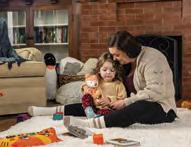
For youth, ages 11 to 14. Students learn about responsible babysitting, basic child development, infant and child care, safety, handling emergencies, age-appropriate toys, business tips and parent expectations.
This is a two-part class, with sessions taking place via Zoom on two consecutive weekend dates. Each session is two hours long. The fee is $50. Learn more, view dates and register at seattlechildrens.org/classes or call 206-987-9878 if you have questions.
CPR and First Aid for Babysitters
For youth, ages 11 to 15. Topics include pediatric CPR, treatment for choking, and first-aid skills. Students receive an American Heart Association Heartsaver Pediatric First Aid, CPR, AED completion card, which is valid for two years.
This class is offered as a two-part series. The series includes a virtual session as well as a short in-person skills check. The fee is $75. Learn more, view dates and register at seattlechildrens.org/ classes or call 206-987-2304 if you have questions.
The Chat
The Chat is an online workshop series on puberty and sex. Offered via Zoom, each 45-minute workshop is for preteens 9 to 12 years old, plus a parent or trusted adult.
You may take any individual workshop or all five. While families can choose to attend any combination of workshops, the information in earlier sessions provides a foundation for understanding later sessions.
The fee is $30 per workshop or the series of five for $100. Learn more, view dates and register at seattlechildrens.org/classes or call 206-789-2306 if you have questions. See a trailer for The Chat at greatconversations.com.
EVENTS Free Online Mindfulness Groups for Parents and Caregivers
Join a culturally relevant mindfulness and compassion session by phone or with Zoom. Sessions are offered for Black parents, parents of a child with special needs, Spanish-speaking parents, as well as any other parents or caregivers. Take part in activities and mindfulness practices led by parents for parents, and share strategies to cope with challenges.
Learn more and view dates and times at seattlechildrens.org/clinics/odessa-brown/ community-programs/mindfulness-program.
Free Car-Seat Checks:
Tuesdays in Bellevue
Learn how to safely secure your child in the car. Child passenger safety experts will check your child in a car seat, booster seat or the seat belt and answer any questions you may have. Car-seat checks are by appointment only and will follow COVID-19 safety protocols.
Learn more and register for an appointment at seattlechildrens.org/carseatchecks.
Free Virtual Car-Seat Checks
King County Certified Child Passenger Safety Technicians are offering free virtual car-seat check appointments via video-chat platforms. For more information, email Laura Miccile at laura.miccile@ kingcounty.gov or call 206-477-8664.
South County Fire and Safe Kids Snohomish County offer free virtual car-seat classes. Registration is required. Visit southsnofire.org/ education/child-passenger-safety.
Celebrating a decade of Igniting Hope, Inspiring Minds, and Changing Lives



portions of fruits and vegetables per day.
According to the current recommendations, children require 1–2 cups of fruit and 1–3 cups of vegetables every day, but the dietary guidelines depend on their age, gender and amount of physical activity they get.
Getting your child to eat vegetables can be quite a tricky affair. Here are some simple but effective ideas to encourage your kids to eat more veggies.
1. Fill half of your child’s plate with fruits and vegetables.
There is scientific evidence that filling half of your kid’s plate with fruits and vegetables increases consumption. In one study, researchers tried two strategies to get kids to eat more fruit and veg: In the first strategy, they added 50 percent more fruit and vegetable side dishes to all of the meals that the kids ate. In the second strategy, they replaced an equivalent proportion of foodstuff with fruits and vegetables. For instance, if they added 10 grams of veggies, they took away 10 grams of mac and cheese.

The results of the studies showed that putting more fruit and vegetables on children’s plates increased their consumption, especially when some foodstuffs were substituted for fruits and vegetables.
2. Rename your veggies.
Sometimes kids react in the most unexpected ways. Researchers from Cornell University found that by naming carrots “X-ray vision carrots,” children ate them much more readily than when those carrots were labeled “food of the day.” If you’re looking for inspiration, another funky name they used in the study was “power punch broccoli.”

3. Try alternative ways of serving veggies.
My kids won’t touch cooked carrots, but they are crazy about raw carrot slices served with a pinch of salt. And, against all odds, they love pineapple and kale smoothies. If you want to get your child to eat more vegetables, try baking, roasting or serving them with a sauce or dip (a genius way to encourage picky eaters) to find out what they will appreciate most.
4. Show your child that not all vegetables are bitter. Most children dislike vegetables because of their bitter taste, but introducing vegetables such as peas or sweet corn can show them that not all vegetables have the same taste.
5. Involve your child in preparing the veggies. Cooking vegetables together is a great bonding activity, and it will also increase the chances that your child will want to taste what they prepared. You can start by checking out recipes and letting them choose a vegetable that they would like to try. (Discover super food recipes kids will love on p. 26).
32 / PARENTMAP.COM
206.494.4708 4200 S. Mead St. Seattle, WA 98118 www.seattlenativity.org Our graudates are attending: Bellevue College, Gonzaga University, Lewis & Clark College, Seattle Central College, Seattle University, St. Martin’s University, United States Air Force Academy, University of Washington, and more! Visit our Open House on February 4, 2022 from 10am—Noon
A flexible and convenient way for people living with disabilities to invest in their quality of life. Plan website: www.WashingtonStateABLE.com Customer Service Center: 1-844-600-2253 or 1-844-888-2253 (TTY) A flexible and convenient way for people living with disabilities to invest in their quality of life. WashingtonStateABLE.com • 1-844-600-2253 0420_wash_state_dept_commerce_1-8h.indd 1 3/6/20 12:26 PM 0920_state_WA_dept_commerce_1-8h.indd 1 8/17/20 12:49 PM
continued from page 31 WELLNESS
When we let our kids have their own garden and choose the vegetables that they wanted to plant, we found that they were more willing to try “their vegetables.” Encouraging your child to start a garden is an easy way to get them to eat more vegetables. In addition to making them eat more veggies, gardening is also a calming activity that is great for developing fine motor skills.
Children require vegetables because they contain certain nutrients that are helpful for healthy development. The good news is that most of these nutrients are present in other foodstuffs as well. If you’re struggling with your child’s reluctance to eat vegetables, alternatives such as kiwi, grapes, dried apricots, oranges and mangoes will ensure that they get the nutrients they need.

There is no need to panic if your child simply will not touch fruits and vegetables. If they are healthy and have a healthy lifestyle (sufficient sleep and physical activity, a generally good overall diet), keep encouraging them to eat veggies and remember that children’s taste buds change over time.


Sanya Pelini, Ph.D., transforms educational research into practical tools and resources on her blog Raising Independent Kids (raising-independent-kids.com).






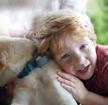

PARENTMAP / JANUARY 2023 / 33 JAN 26-29 TACOMA DOME BOX OFFICE SAVINGS $5 * Present this coupon at the box office. One per person. Cannot be combined with any other offers. Opening Day FREE on Thursday
through garden displays and shop from a selection of annuals, seeds, bulbs and houseplants to bring home
your
Wander
and kickstart
grand and glorious garden. 6. Grow your own vegetables.
Schedule an evaluation before April 2023 to receive ONE FREE SESSION! Peregrine Therapy • Speech-Language Therapy • Services Available in English & Japanese • Before and After School • No Wait List • Redmond location peregrinetherapy.com 425-689-8570 (call or text) 0123_peregrine_therapy_1-8h.indd 1 12/2/22 9:16 AM ■ Fun in your inbox Stay up to date with the latest family news, stories and adventures around Puget Sound — straight to your inbox. ParentMap.com/eNews
January Play List
Resolve to play more in 2023
By Nancy Chaney
Check out many more happenings online at parentmap.com/calendar.
It’s a new year and a chance for a fresh start. Short gray days? Who cares? We’re putting on our mittens and going ice skating, exploring in the park and wandering among the lights. We’re also taking off our mittens and diving into the lake. (Wait, what? Did I agree to this?) Plunge into 2023 with these ways to find fun and meaning with your fam. Happy New Year to all!
� Bask in the sparkle well into January by walking the Tacoma Light Trail, a series of light-art installations set up around downtown Tacoma. Artworks will light up the dark and (otherwise) dreary nights through Jan. 19, with special performances at Tollefson Plaza at 6 p.m. on Jan. 1, 6 and 7. Free. parentmap.com/light-trail

� Make live music a family affair with tot-focused bands returning to play the Mount Baker Community Club. Book your tix to one or more Kindiependent artist shows kicking off the new year. Dani & the Bee get buzzy on Saturday, Jan. 7, and kiddie faves The Not-Its! rock the clubhouse on Sunday, Jan. 21. Tickets $10. parentmap.com/kindiependent
� Marshal your courage and rally the bravest among your crew to start the new year off with a very cold splash. The Seattle Polar Bear Plunge is back! Show up at Matthews Beach and dive into Lake Washington on Sunday, Jan. 1, right at noon. Free. parentmap.com/polar-plunge
� In winter we’ve got to chase the vitamin D when we can, but even if the elements deliver drizzle, time spent outside is always worthwhile! Washington’s state parks entice your fam outdoors, so bundle up to enjoy two free-entry days this month, Jan. 1 and 16, when you don’t need to display a Discover Pass to park. Fresh air, towering trees and winter wildlife await. parentmap.com/free-days
� Glide into your 2023 — smooth as ice — at seasonal skating rinks around town. Skate at Bellevue Downtown Ice Rink through Jan. 8; at Pacific Ice in Everett and Arlington’s Holiday Ice Rink
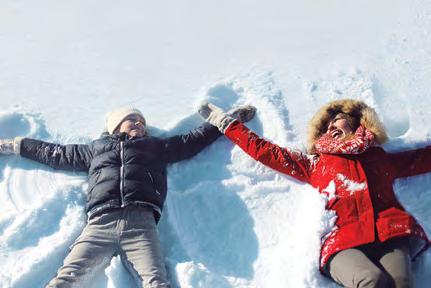
FAMILY FUN
Tacoma Light Trail hops lanterns.
34 / PARENTMAP.COM
Photo by Nikki McCoy
Highlighted Events for January
Jan. 14–15
Tet in Seattle Center
Online parentmap.com/tet
Jan. 16 | Monday
Martin Luther King Jr. Day events
All areas parentmap.com/mlk-day
Jan. 19 | Thursday
ParentEd Talks: Khalil Gibran Muhammad, Ph.D., and Jeffery Robinson
Online parentmap.com/live
through Jan. 9; at Oly on Ice through Jan. 16; and at Snohomish Valley Ice Rink all the way ’til Feb. 26. Book your skate session online and plan to spend $12–$17 per person, including skate rental. parentmap.com/skating

� The best happy hour in town is back! And it’s for families. Head to Central Cinema for dinner on Thursdays and enjoy cartoons on the big screen to accompany your meal. Cartoons for the kids, adult bevvies for the tired parents, dinner and laughs for everyone — genius! Thursdays, Jan. 5, 12, 19 and 26, 5–7 p.m. Cartoons free; food and drink for purchase. parentmap.com/ cartoon-happy-hour
� Skagit County welcomes visitors to join free nature walks and spy eagles during the Skagit Eagle Festival. The guided nature walks start from Howard Miller Steelhead Park in Rockport on weekends this month, Jan. 7–8, 14–15, 21–22 and 28–29, at 11 a.m. and 1:30 p.m. parentmap.com/eagles
� Gather your crew ’round the laptop for an interactive story time hosted by the Northwest African American Museum This month features the book “Martin’s Big Words: The Life of Dr. Martin Luther King, Jr.” to help kids and families learn more about MLK’s vision and the eloquent way he presented it. Sunday, Jan. 8 at 1 p.m. parentmap.com/naam-stories
� Celebrate Lunar New Year, Vietnamese style, at the annual Teết in Seattle fest. Join Seattle’s strong and proud Vietnamese community to enjoy cultural traditions, performances and food to mark the new year. This free fest takes place at Seattle Center, Saturday–Sunday, Jan. 14–15, 11 a.m.–6 p.m. parentmap.com/tet
� Honor the life and carry forward the vision of the Rev. Martin Luther King Jr. by joining with the Seattle MLK Jr. Organizing Coalition for its annual community rally and march, starting at Garfield High School. Monday, Jan. 16. Free. parentmap.com/mlk-rally
� Block out an hour for an essential ParentEd Talks event, “Past Forward: The Legacy of Racism in Modern-Day America.” Join two of the nation’s leading scholars on race, democracy, inequality and criminal justice for a discussion on the hidden history of racism in the United States and how to
forge a path forward. Preregister for this free talk and tune in Thursday, Jan. 19, at 1 p.m. parentmap.com/live
� Bundle up for a free outdoor family date night. Explore a Puget Sound beach alongside Seattle Aquarium beach naturalists during an evening minus tide. What fascinating critters will you spot with your headlamps? Friday, Jan. 20, 8–10 p.m. parentmap.com/beach-walk
Woodland Park Zoo’s WildLanterns show lingers into the new year, open Thursday–Sunday through Jan. 22. It’s a splurge, at $26–$35 per person, but your ticket purchase supports the animals in the zoo’s care.
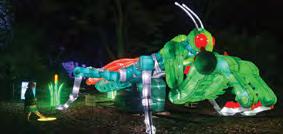
parentmap.com/wildlanterns
� Kid-favorite indoor destination The Museum of Flight invites families with children who have sensory needs to its free Sensory Day on Saturday,
� Do you want to build a snowman? Well, here’s your chance! Gather in the meadow at Chambers Creek Regional Park to learn to make your own snow, which you can use to sculpt a snowman or other snow creation! While you learn, enjoy free hot drinks to keep you warm. Saturday, Jan. 21, 10 a.m.–1 p.m. parentmap.com/snowman

� Perhaps gloomy January is when we really need the enchantment of a dazzling light display. If you haven’t been,
Jan. 28, 8–10 a.m. Preregister for free access to awesome aviation exhibits, with adjusted light and sound and fewer other guests.
parentmap.com/sensory-day
WildLanterns 2022. Photo by Nancy Chaney
PARENTMAP / JANUARY 2023 / 35
Nancy Chaney is ParentMap’s Out + About editor.
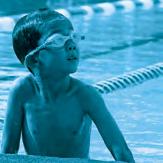
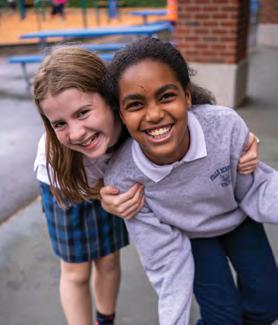






Grants & Flexible Tuition Available | Inquiry Based | Low Student-Teacher Ratio | Inclusive | Transportation Available INQUIRY EXPLORATION CREATIVITY REFLECTION FUN EARLY CHILDHOOD THROUGH 8TH GRADE Contact us at admissions@jds.org | www.jds.org Now accepting applications for 2023-2024! “ Why JDS? In particular, we treasure the emphasis on learning to be a good human being, the warmth of the faculty and administration, and all the little ways we see our son think better, emote better, and act better as he learns from those around him.” Parent, March 2022 samenA SAMENA PRESCHOOL 425.746.1160 SAMENA.COM NOW ENROLLING FLEXIBLE PROGRAMMING SWIMMINGSPANISH MUSIC thevilla.org | Seattle, Washington C M Y CM MY CY CMY K ai167044096810_ParentMap_12-7.pdf 2 12/7/22 11:22 AM 36 / PARENTMAP.COM LOCAL RESOURCES / SCHOOLS + PRESCHOOLS





























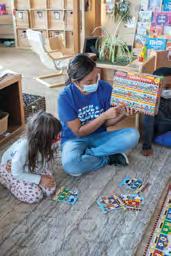


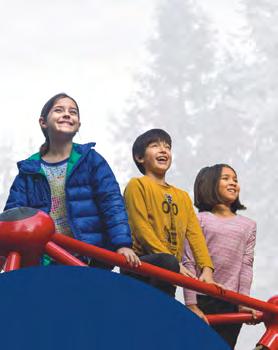
PARENTMAP / JANUARY 2023 / 37 seattleymca.org/ earlyeducation NOW ENROLLING AGES 6 WEEKS TO 5 YEARS Building Bright Futures Y Early Education programs are enriching and positive places to learn, grow, and thrive. Auburn North Seattle Redmond West Seattle Woodinville Visit seattle.gov/applySPP to apply online. Need assistance filling out the application?We can help! (206) 386-1050 or preschool@seattle.gov Be Kindergarten Ready! Financial Assistancefor Families Extended-Day ChildCare Options DualLanguage Classrooms Available Nationally Recognized for Quality LOCAL RESOURCES / SCHOOLS + PRESCHOOLS
Nature Is the Best Teacher
Local preschools offer joyful learning in the great outdoors

Interest in outdoor preschools has been growing for decades. The concept took shape in the 1950s in Sweden and Denmark; in the late 1960s in Germany, which is now home to hundreds of “forest kindergartens”; and more recently in the United Kingdom and United States.
Local outdoors-focused preschools have various philosophies and curricula, but all of them focus on getting young children into nature for long stretches of time.
Seattle-area outdoor preschools
Tiny Trees Preschool ● tinytrees.org
Nine park locations in Seattle, Kirkland and greater King County Tiny Trees Preschool offers an innovative model that combines affordability and nature orientation, and aims to provide children with a joyfully muddy childhood. At Tiny Trees, kids ages 3–5 spend three and a half hours outdoors in either a morning or afternoon class.
Anna’s Little Farm Preschool ● annaslittlefarm.com Columbia City
Children ages 3–6 spend all day outdoors, including lots of time interacting with animals on the farm. There is the added benefit of a bilingual teacher and Spanish-speaking staff members weaving language lessons into the day. Teachers emphasize emotion coaching and play-based education.
Seattle Children’s PlayGarden Preschool ● childrensplaygarden.org/preschool
Mount Baker
Children ages 3–5 spend most or all of their school day outside in the PlayGarden, an innovative park, garden and play space designed to be inclusive for kids of all abilities.
Little Wildlings Nature School ● littlewildlingsnatureschool.com
Mount Baker
This urban forest preschool welcomes children ages 3–5. Hours are 8:30 a.m.–12:30 p.m., with aftercare options available.
Discovery Park Nature Kids Preschool ● seattle.gov Magnolia
The first nature-based preschool program in Seattle for children ages 3–5, Nature Kids Preschool is a program of Seattle Parks and Recreation that’s located in Seattle’s largest greenspace, Discovery Park.
Note: Due to ADA renovations, Discovery Park Nature Kids Preschool is currently closed. It will reopen for the 2023–2024 preschool year.
Fiddleheads Forest School ● botanicgardens.uw.edu Washington Park Arboretum
The only building used for this University of Washington program is a greenhouse! For children ages 3–5, there are two-, three- and five-day options for classes that run from 9 a.m. to 1 p.m. For children ages 4–6, there are full-day (9 a.m.–3 p.m.), five-day preschool and afternoon enrichment class options.
Woodland Park Cooperative School ● woodlandparkcoop.com Fremont
Children ages 2–4 spend half of their school day outside. This school is part of the North Seattle College Cooperative Preschools program. The school is known for its creative, child-led curriculum.
Tara’s Tots Schools ● tarastots.com Multiple North Seattle locations
Tara’s Tots offers three play- and nature-based preschool programs in North Seattle. Each school has a fully fenced play yard as well as an indoor play area. A home-school enrichment program called Roots of Connection (ROC) is offered for kids ages 4 and older at Woodland Park.
Matthews Beach Playschool ● matthewsbeachplayschool.com Northeast Seattle
Children ages 3–5 spend all of their time outdoors, alternating
LOCAL RESOURCES / SCHOOLS + PRESCHOOLS
38 / PARENTMAP.COM
Chavitos Nature School in Tacoma
Changing the Face of Private School Education
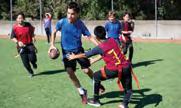
BASIS Independent Bellevue offers a global approach to private school education that develops high-performing, independent learners. With a focus on interdisciplinary instruction and experiential learning, our program builds critical inquiry as students engage in the liberal arts and STEM.
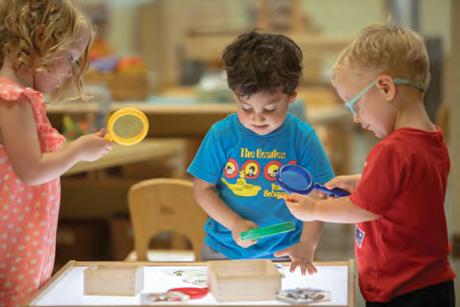

Schedule a campus tour today. Learn more at bellevue.basisindependent.com.
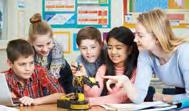
LOCAL RESOURCES / SCHOOLS + PRESCHOOLS PARENTMAP / JANUARY 2023 / 39
between nature explorations in Matthews Beach Park and a fenced-in outdoor space with a sandpit, playhouse, planter boxes, fairy garden and covered areas for working on projects.
Seattle Waldorf School Preschool Program ● seattlewaldorf.org Northeast Seattle
Children ages 3–5 spend an hour to an hour and half every day in the outside play yard, where there are places to climb, pour water and play with sand; the yard also features fruit trees and a cob oven for baking activities.
Wildflowers Preschool ● wildflowersschool.com Columbia City
Affordable and accessible due to its below-market tuition rate, Wildflowers has created a partnership with Tiny Trees Preschool at Jefferson Park so that children have the potential to have a full day of nature-based preschool with a seamless transition from Tiny Trees (mornings) to Wildflowers (afternoons).
Eastside-area outdoor preschools
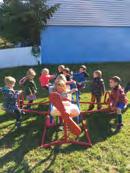
Field & Forest Preschool ● fieldandforest.org Woodinville
Children ages 3–5 spend the day on a 5-acre wooded site, enjoying play-based learning with an emphasis on natural materials, inquiry, autonomy and community; circle time takes place in an authentic 18-foot-tall tepee.
Roots and Wings Nature Preschool ● wildernessawareness.org Duvall
Through nature activities for kids, including songs, stories and walks, as well as plant and animal observation, the Roots and Wings curriculum plants seeds for children’s growth and connection with nature. Roots & Wings is a program of the popular Wilderness Awareness School.
Nature Explorer ● wildernessawareness.org Cougar Mountain Park and Saint Edward State Park
Through creative play and exploration, participants ages 4–6 work together in small groups, gaining nature awareness and knowledge of plants, mammals, birds, and tracking and survival skills. Nature

Explorer is a program of Wilderness Awareness School.
Tike Hikes Outdoor Preschool ● tikehikespnw.com Redmond Ridge
This Reggio-Emilia–inspired, 100 percent outdoor preschool with a nature-based curriculum is located on 5 private acres that were once a nature preserve. Classes for ages 2–5 are available in the morning, and afternoon classes are for kids ages 4–8.
Tiny Treks NW ● tinytreks.com Redmond
This play-based and exploration curriculum for children ages 3–5 is patterned after the forest kindergartens of Europe. Each day, the children play outside, explore and learn in the forest, hike on trails, play along the creek and tend the garden.
Natural Start Preschool ● naturalstartpreschool.com Bellevue


Children ages 3–5 spend 45–90 minutes outside during each class day; repairing to the large gym at South Bellevue Community Center during extreme weather conditions. The school has access to 39 acres of natural habitat that includes forests, meadows, hiking trails and a stream.
The Mason Jar Farm School ● greenplaynw.org Enumclaw
This play-based, all-outdoors program for children ages 3–6 is located on a working CSA farm that includes raised garden beds, fruit trees, chickens, rabbits, miniature horses and a seasonal creek.
Cedar Valley Forest School ● greenplaynw.org Maple Valley
In this “hands-in-the-earth and feet-in-the-puddles kind of program,” kids ages 3–6 get dirty, learning to follow the rhythms of the earth and seasons of nature, right down to the snacks they eat.
Nature Nuts ● naturenuts.org Maple Valley
This accredited year-round forest kindergarten program combines unstructured nature-immersion time, flow learning and an inquiry-based teaching style for students ages 2–7.
northseattlecoops.org
continued from page 39 LOCAL RESOURCES / SCHOOLS + PRESCHOOLS
GigHarbor'sonlyparent-involved, co-oppreschool.Focusesona play-basedcurriculumfor2's,3's, andpre-K. FamiliesLearningTogetherSince1962 FallregistrationbeginsJan.20LearnmoreatGHCP.org North Seattle College Cooperative Preschools and Parent Education Program
A program for children from birth to 5 years and their caregivers. NOW ENROLLING FOR THE CURRENT SCHOOL YEAR AND FALL 2023 0123_NSCC_1-8h.indd 1 12/6/22 11:08 AM 40 / PARENTMAP.COM
Nurture in Nature Preschool ● metroparkstacoma.org
Tacoma Nature Center
Nurture in Nature preschoolers spend at least an hour each day outside at this nature- and discovery-based program, which is located on 71 acres of land at the Tacoma Nature Center at Snake Lake.
Chavitos! Nature School ● chavitosnatureschool.com
Tacoma
This bilingual school, located on almost an acre of Native land, is 100 percent outdoor nature immersion, with a child-driven approach based on discovery rather than a set curriculum. Chavitos! serves students ages 2–5 with morning, afternoon or full-day options.
PlaybasedPreschool



Wind Gatherers Nature Program ● vashonwilderness.org
Vashon Island
Children ages 4–6 spend the entire day outside in this place-based, nature immersion program. Flowing with the seasons, this approach fosters self-reliance and community through compassionate communication, beach and woodland exploration, awareness skills, quiet time in nature, journaling and improvisational play.
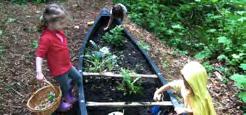

■
Editor’s note: This article by Nancy Schatz Alton was first published a few years ago and is updated each year by ParentMap editors.

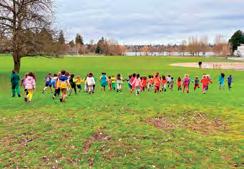






LOCAL RESOURCES / SCHOOLS + PRESCHOOLS
fullofopportunitiestoexploreourworldwith hands-onlearninginasafenurturingChristcenteredenvironment.Activitiesareplannedto scaffoldchildren’slearningtotheirnextlevelas wellassetupenriching,stimulatingenvironments. FaithFocused Tonurtureandbuildachild’sspiritual growthandcharacter,weshareour ChristianfaiththroughBiblestories,prayer andweeklychapel. Full-Time&Part-Time HopeSchooloffersfullandpart-time programs,fourandfivedays/weekfrom 7:30amto5:30pm. HLS.HopeSeattle.org 206-935-8500 ENROLLINGNOW SCHEDULEATOUR Preschool-Grade8 Experience Seattle's Independent Jewish Day School, located in the heart of the Green Lake neighborhood. www.sjcs.net/admissions Tours and applications for the 2023-2024 school year now available! PARENTMAP / JANUARY 2023 / 41
Our3and4year-oldprogramisahappyplace
South Sound and Vashon Island
Photo courtesy Seattle Waldorf School
Photo courtesy Mercer Slough Polliwogs Preschool

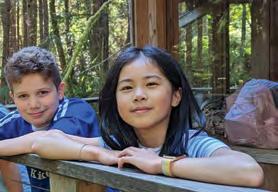


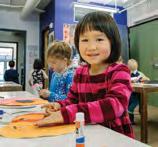


LOCAL RESOURCES / SCHOOLS + PRESCHOOLS Each Primrose School is a privately owned and operated franchise. Primrose Schools is a registered trademark of Primrose School Franchising SPE, LLC. ©2022 Primrose School Franchising SPE, LLC. All rights reserved.
|
Learning
exciting, and your
is built to learn
learning is fun, it lasts a lifetime. @etonschool.washington @EtonSchoolWA etonschoolwa 2701 Bellevue-Redmond Road Bellevue WA 98008 “Eton School has done an excellent job preparing my children to be compassionate leaders and problem-solvers.” ~Parent of Alumni 425-881-4230 Learn more about our program, schedule a tour, and get answers to your questions! www.etonschool.org/admissions Open House: 7 January 2023 From 10 a.m. -12 p.m. Accepting Applications for Age 3-Grade 8 @ Gifted children exhibit these characteristics every day. Even so, many gifted students, especially children of color, remain overlooked in class. Not so at Seattle Country Day School. We offer our students an environment where they can ask questions, create, and grow intellectually and emotionally. See if SCDS is right for your child. Reach out today to admissions@seattlecountryday.org. Logical + Imaginative + Intense + Verbal + Observant + Hands-on Seattle Country Day School For gifted children, K–8 Rooted in inquiry. Dedicated to equity. seattlecountryday.org/admissions Apply Today! www.seattlenativity.org/admission A faith-based, tuition-free, STEM education. 206.494.4708 4200 S. Mead St. Seattle, WA 98118 Open House Saturday, February 4, 2023 10am—Noon Seattle Nativity School celebrates 10 years of rigorous education, nourishing souls, and igniting leaders for love and service in the Jesuit tradition. Serving middle school students with support through high school and college. 42 / PARENTMAP.COM
Primrose School of West Bellevue 425.315.7305
PrimroseWestBellevue.com
is
child
with a natural curiosity that knows no bounds. Through a balance of play and nurturing guidance, Primrose school teachers foster that curiosity and help your child feel a sense of pride and accomplishment that lays the foundation for a lifelong love of learning. When















































LOCAL RESOURCES / SCHOOLS + PRESCHOOLS smallworldmontessori.com 425-338-7771 Please email: info@smallworldmontessori.com or call to schedule a tour Preschool ages 3-5 in Everett/Mill Creek 27+ Years of Service! The Learning Issue ParentMap.com/learning Reimagine school-based learning throughout the year with our expert tips and resources. Raise capable and confident learners. thevilla.org | Seattle, Washington C M Y CM MY CY CMY K ai167044096810_ParentMap_12-7.pdf 1 12/7/22 11:22 AM PARENTMAP / JANUARY 2023 / 43

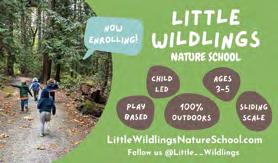


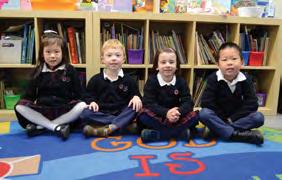









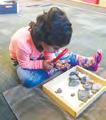
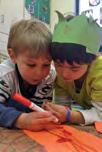


LOCAL RESOURCES / SCHOOLS + PRESCHOOLS 44 / PARENTMAP.COM PRESCHOOL PREVIEW January 12, 2023, 7:00pm Join Us Online in January! ELEMENTARY INFO SESSIONS January 19 & 26, 2023, 7:00pm NOW ENROLLING FOR 2023-24 www.ecswa.org Experience Exceptional Education in a Christ-Centered Community www.sammamishmontessori.com 425-883-3271 The Sammamish Montessori School In Redmond Call 425-883-3271 for a tour. Child-centered, joyful atmosphere with strong academic focus Preschool, kindergarten, and STEAM Enrichment Family owned and operated since 1977 Now Enrolling FD20_sammamish_montessori_1-8h.indd 1 7/30/20 5:20 PM Enrollment Open for Spring 2023 & 2023-2024 School Year! PNA WHITTIER KIDS PRESCHOOL Learn more at phinneycenter.org Dedicated to nurturing the growth and development of early learners in a caring, safe and fun environment onsite at Whittier Elementary.
What I Wish I’d Known About Mammogram Callbacks
By Gina Rich
Because my mother and maternal aunt had breast cancer, I had my first screening mammogram relatively early, at age 36. After the exam, the technician told me to expect a letter in the mail in about a week if everything looked normal.
But two days later, an unfamiliar number popped up on my phone. “This is the imaging center,” said a calm voice when I answered. “We need you to come back for some additional views.” My stomach churned, as if I’d swallowed a beaker full of acid. What, exactly, had shown up on my mammogram?
What is a mammogram callback?
Sometimes referred to as a recall, a mammogram callback occurs after a routine screening and indicates that the doctor wants to conduct additional tests to look at something more closely.
Importantly, a callback arises “because we see something that might be abnormal. It doesn’t mean for sure that it is,” says Roberta
Strigel,
Callbacks often happen after screening mammograms, but can also take place after a screening ultrasound or MRI. About 10 out of 100 women will get a callback after a screening mammogram, says Strigel.
It’s normal to feel worried about a callback. But here is a reassuring statistic: “Only about 5 percent of women who are called back from a screening mammogram will have a breast cancer diagnosis,” says Nicole Winkler, M.D., a radiologist at the Huntsman Cancer Institute and an associate professor of radiology at the University of Utah.
During a callback appointment, diagnostic imaging is conducted on the area of concern. Diagnostic imaging can provide more detail than screening mammograms, which are for patients who don’t have any signs of breast cancer. Tests may include a breast ultrasound, an MRI or a targeted mammogram.
 M.D., section chief of Breast Imaging and Intervention at the University of Wisconsin School of Medicine and Public Health.
M.D., section chief of Breast Imaging and Intervention at the University of Wisconsin School of Medicine and Public Health.
PARENTMAP / JANUARY 2023 / 45
Unlike at a screening mammogram, a radiologist looks at the images immediately and visits with you to explain the results.
According to Strigel, of the 10 out of 100 women who are called back, six will be told everything is fine and to return next year for their regular screening. About two will be asked to come back sooner — typically in six months — to confirm the stability of an almost certainly benign finding. Only one to two women will be advised to have a biopsy; the majority of these biopsies indicate there is no cancer.
Since my first mammogram several years ago, I’ve experienced all of the above scenarios at least once. Although everything turned out okay, the uncertainty was extremely anxiety-provoking. Here’s what experts say about why callbacks occur and how to cope.
Why mammogram callbacks happen
If you get a mammogram callback, first remember that “the likelihood of something being cancer is low,” assures Winkler. Two of the most common, unserious callback reasons are cysts and overlapping breast tissue.
Breast cysts are benign, fluid-filled areas that show up on a mammogram. “We see cysts all of the time. They’re very common,” says Strigel. A screening mammogram alone can’t show the radiologist that something is a cyst, so typically an ultrasound is needed.
Overlapping tissue occurs when breast tissue is superimposed on top of itself during the compression of a mammogram, creating a “pseudo-mass” that can look suspicious, says Nikki Tirada, M.D., section chief of Breast Imaging at the University of Maryland Medical Center and assistant professor at the University of Maryland School of Medicine. In this case, radiologists need to obtain additional images in different positions to see if the mass disappears.
What else might affect your chances of a callback? One consideration is the type of mammogram performed.
Tirada notes, “3D mammograms have been shown to somewhat reduce recall.” Also called digital breast tomosynthesis, 3D mammography differs from traditional two-dimensional mammography because it enables radiologists to see each breast at multiple angles, reducing the risk of overlapping tissue.
Your medical history makes a difference, too. If you’ve had prior biopsies — even benign ones — or have a family history of breast cancer, “our alarms go off, and we look a bit more carefully,” says Tirada.
The length of time between screenings also influences the likelihood of getting called back. With regular annual exams, radiologists can compare your current images to previous ones. Many patients have benign breast masses or calcifications that are harmless, says Tirada. “If they were there on your prior mammogram, I feel confident letting it go,” she adds. Along these lines, “The likelihood of being called back from your very first mammogram is higher than subsequent mammograms,” says Winkler, because radiologists don’t have previous images to establish whether something is normal for you.
If you’re playing catchup on your screenings, you’re not alone: A July 2021 study in the Journal of the National Cancer Institute estimated that due to the pandemic, 50 percent of women missed their screening mammograms in 2020. It’s important to get back on track, Tirada says.
If you’ve recently had a COVID-19 vaccine or booster, she advises scheduling any imaging at least six weeks after the shot. That’s because the vaccine sometimes causes temporary, harmless swelling of the lymph nodes under your arm that can be mistaken for an abnormal finding.
One caveat: If you’re experiencing symptoms such as a lump, nipple discharge, or dimpling or pulling in of the breast, ask your doctor about being examined sooner.
What to do while you wait for follow-up testing
Though the time between a callback and follow-up testing is usually only a few days, waiting can trigger anxiety. After my first callback, I immediately went online and began scrolling through breast cancer chat boards. Reading others’ anecdotes only increased my fears.
“I never want to tell people they can’t get on the internet, because we all do right away,” says Strigel. But it helps to limit consultations with Dr. Google if you can. Know that a radiologist will explain everything in person at your appointment.
In the interim, you can always ask to speak with someone sooner. Although the person who calls to schedule your imaging typically can’t share specifics, that doesn’t mean the findings were cancer or information is being kept from you, says Strigel; the scheduler simply doesn’t know.
If you ask, most radiologists are happy to talk through screening results over the phone. In the past, I’ve also called my primary care physician, who has access to my results and can give me a sense of what the radiologist saw.
continued
WELLNESS
from page 45
46 / PARENTMAP.COM
Even though doctors cannot know the results definitively until diagnostic testing is complete, speaking with a trusted medical professional can put runaway worries into perspective while you wait.
Above all, remember that the benefits of screening outweigh the risks. “In the small chance that a cancer is found, the vast majority are early-stage,” says Winkler. That means less treatment — a patient might not need chemotherapy, for example — and a reduced risk of dying from breast cancer.
Strigel agrees: “You did the right thing by going in for your screening.”
If your results say you have dense breast tissue, you’re in good company: Fifty percent of women have dense breast tissue. Knowing your breast density is important for two reasons. First, having dense breasts slightly raises your risk of developing breast cancer. In addition, both dense breast tissue and cancer look white on mammograms, so having dense breasts can make it trickier to detect a problem.
Speak with your health-care provider about how your breast density and other risk factors might affect your screening plan. Annual mammograms are still recommended if you have dense breasts, but some women may benefit from supplemental imaging, such as breast MRI or whole breast ultrasound.
■
Gina Rich is a Wisconsin-based freelance writer who focuses on parenting, health and the natural world. This article was first published on Next Avenue (nextavenue.org).


dol.wa.gov/vehicleregistration/spkidssafe.html


My results say I have ‘dense breast tissue’ — what does that mean?
PARENTMAP / JANUARY 2023 / 47
When you purchase a Keep Kids Safe license plate, you help keep children of all ages healthy and safe.
money by renewing tabs earlyand order new plates! 1122_wa_state_del_1-4.indd 1 10/18/22 1:22 PM
Save
Women and Family Wellness Studio













L AS E R Daytime Laser Show Light it up at pacsci.org/laserdome Laser Movie Magic Laser 90s • Laser Taylor Swift
Counseling •
•
•
• Resources •
thewfws.com Support to uplift women, men, and families in every way possible, focusing on mind, body and soul
Parenting Classes
Education Support
Postpartum Workshops
Online Yoga
Appointments available
1122_women_fam_wellness_studio_1-4.indd 1 10/13/22 3:25 PM 48 / PARENTMAP.COM
Jasmine McCarthy, LMHCA, provides counseling for kids 5 to 18 years old plus young adults. Jasmine offers her services in client homes in the greater Seattle area, or via telehealth throughout Washington state. Incredible Years Parenting Program • Evidence-based parenting classes offered online in group settings or in family’s home • Classes for parents with kids of all ages
immediately!
Ages + Stages
Sleepover Guidelines That All Parents Should Know

Keep these important tips in mind for your kid’s next sleepover
By Gemma Alexander
The sleepover is one of the most beloved experiences of childhood — remember the slumber party from “Grease”? Watching it as an adult, that iconic scene looks a lot like bullying. Sleepovers can be among childhood’s best and worst memories. And the same thing that makes them exciting for kids — being away from home for a whole night — makes them scary for parents. There’s not much we can do after dropping them off to make sure they have a good time. But preparation and good timing can improve the odds of a sleepover becoming a night to remember for all of the right reasons.
Know the right age for your kid.
There is no universal perfect age for a first sleepover. As with all milestones, the right time is when your child is ready. Some tod-
dlers routinely sleep over at a friend’s house, while some tweens aren’t ready yet. The context of the sleepover can be the deciding factor for a child who is on the fence. A sleepover with a best friend at a house where your child plays regularly is much less challenging than a big slumber party for a random classmate’s birthday.
If your child gets an invite to a sleepover, ask them if they want to go. An enthusiastic response is no guarantee that reality will live up to expectations. But you might be surprised at how well your kid knows their own boundaries. If they want to go but feel anxious (actually, even if they aren’t anxious), take time to talk through what to expect before deciding.
PARENTMAP / JANUARY 2023 / 49
See the award-winning film, WHO WE ARE: A CHRONICLE OF RACISM IN AMERICA, now streaming on Netflix. thewhoweareproject.org


from page 49

Set expectations.
Nervousness or other issues such as sleepwalking or bed-wetting do not necessarily preclude sleepover attendance. But you should give the hosting adult a heads-up to make sure they are prepared and willing to handle it. And talk to your child about what to do if those issues come up during the sleepover — for them or for another child at the sleepover. Setting clear boundaries and expectations with both your own kid and the hosting parents is critical to making sleepovers work.

For kids (and parents) who like the idea of a sleepover but are made anxious by the prospect, hosting may be a more comfortable option for their sleepover debut. And if your child is still afraid after learning all of the details, no problem. There will always be another chance later.
Ask questions.

It’s easy to focus on social anxieties and forget that different families may not have the same attitudes about safety that you do. It can feel awkward to ask questions before a sleepover, but it is your responsibility to know who will be playing with your child and who will be watching them. You should also find out what activities are planned and if there are guns in the home where your child will be staying. A parent who is offended by these questions is probably not one you want hosting your child overnight.

Have an exit strategy.
Sleepovers are a rite of passage, but they shouldn’t be an ordeal. There’s no need for a child to power through if they get scared or homesick at bedtime; or if the group chemistry is off and a child feels left out, or doesn’t want to play the game they don’t like (or know you wouldn’t).
AGES + STAGES
continued
Jeffery Robinson, a former ACLU Deputy Legal Director, has been traveling the country for the past 10 years, asking all of us to examine who we are, where we come from, and who we want to be.
1022_who_we_are_project_1-2v.indd 1 8/23/22 12:22 PM 50 / PARENTMAP.COM
Be sure that both your child and the hosting parents know that you don’t mind picking your kid up at any time, for any reason. Having an exit strategy is especially important if your child has never been to a sleepover before or if it’s with a new group of friends. Sometimes just knowing they have the option to go home makes it easier to stay until morning.
Plan accordingly for the next day.


If all goes well, your child will have a blast with their friends. They will watch movies, eat too many snacks and play silly games until long after they normally would be in bed. They will come home happy — and exhausted. Sleepovers rarely involve a good night’s sleep. Plan for sleeplessness, and don’t build conflict into your schedule.


If your child has an important soccer game on Saturday, don’t send them to a sleepover on Friday. Similarly, if you’re committed to a sleepover, don’t plan a big family outing the next day. Everyone needs recovery time after a big event, and kids are no exception. Expect them to be a little tired and cranky after their big night out, and let them take it easy the next day.
■ Find support, connection, and resources for your family! PEPS offers peer-support programs for expectantparents,parents of newborns,infants,oradolescents and teens, plus affinity groups. Families connect on weekdays and weeknights in virtual,in-person, and hybridgroups. Join a PEPS Group today! Flexible Pricing program fees and Financial Assistance available all groups. E Q D M peps.org

Seattle-based freelance writer Gemma Alexander focuses on the intersection of parenting and the arts. When she’s not writing for ParentMap, she blogs at gemmadeealexander.com and tweets @gemmadeetweet. PARENTMAP / JANUARY 2023 / 51
Repair the World
What Happens in the Classroom Can Happen in Society
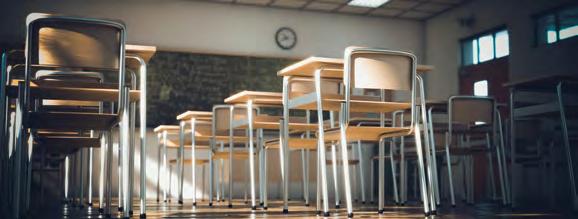 By Mark Jones, Ph.D., and Rabbi Jay Rosenbaum
By Mark Jones, Ph.D., and Rabbi Jay Rosenbaum
Editor’s note: Throughout 2023, ParentMap will feature opinion pieces by passionate voices that will uplift and inform perspectives on concrete ways to “repair the world.”
Professor Edward Frye once taught that classroom teachers often make a classic mistake. They think that if they just get rid of the three worst troublemakers in the class, their classroom will be a paradise. What they find is that when they get rid of these three bad actors, three others take their place. No one questions the right of a teacher to discipline a student who is acting out. But, if the teacher has to throw out half of the class, then maybe it’s the class environment that needs to be changed.
Since the 1990s, our criminal justice system has been functioning like a school with a poor classroom management strategy. It has operated under the assumption that certain people are inherently bad actors, and that if we just get rid of them, lock them up and throw away the key, then we will be safe. The result is that the United States incarcerates exponentially more people than any other free society in the world.
The problem with “bad actor” thinking is that it is tends to mushroom. We start by dehumanizing the most marginal in society
and we end up dehumanizing our next-door neighbor. Recently, a Tennessee parent suggested that school librarians who stock books that parents consider inappropriate for children be charged with a criminal offense. And, not long ago, a presidential candidate led a crowd in chanting “Lock her up!” in reference to his political rival. In a democratic nation, incarceration should be a last resort. But, in a society in which we have come to view half of our fellow citizens as criminal, incarceration seems like a reasonable first response.
That is why a year ago, a local multiracial grassroots group that includes Christians, Jews, Muslims, Buddhists and Quakers formed the Multifaith Coalition for Restorative Justice. Restorative justice offers an alternative to the “bad actor” mindset. It posits that when one person does harm, there is a tear in the fabric of the community. Of course, each of us individually is responsible for our own behavior. But none of us is an island. We live in communities. And our environment can set us up for moral success or moral failure. That’s why whenever harm is inflicted, it’s the community as a whole that must respond.
Sometimes the power of community emerges from unexpected places. Just ask Kimonti Carter, whose story is told compellingly in Gilda Sheppard’s film “Since I Been Down” (sinceibeendown.com). Kimonti joined a gang at the age of 11. He was sentenced to 770 years in prison for a crime he committed at age 18. By age 41, Kimonti had become an inspirational leader within the prison system. The program he initiated, TEACH [Taking Education and Creating History; blackprisonerscaucus.org/teach] has brought together incarcerated Black, Latino and even white supremacist men in the kind of interracial fellowship that has never existed anywhere in the Washington state prison system until now. Had we met Kimonti at age 18, we might have dismissed him as a
52 / PARENTMAP.COM
bad actor. And we would have had no idea of the person he was capable of becoming. What is the difference between the 18-yearold Kimonti and the 41-year-old Kimonti? Kimonti himself would tell us: “Community.” At age 11, Kimonti’s life was shaped by community conditions that made it almost inevitable that he would make poor decisions. But in prison, Kimonti was mentored by men in the Black Prisoners’ Caucus who saw in him qualities he hadn’t seen in himself. Through the nurturing of this positive community, Kimonti flourished and he went on to create a beloved community of his own.
But imagine how Kimonti’s life would have been different if he hadn’t had to wait until he entered prison to find the community conditions that would enable his fullest potential.
We cannot go back in time and provide the 11-year-old Kimonti with the kind of environment that would have given his life an entirely different trajectory. But we can help future Kimontis. As a community, we can cultivate the conditions that will make it less likely that future Kimontis will end up in prison in the first place. We can make it more likely that a person who goes to prison will transform his life for the better. And we can make it more likely that the people who are released from prison will succeed by creating a welcoming environment they can truly call home.
After serving 24 years, Kimonti was recently resentenced and released, and he has reentered society. It would be ironic, indeed, if, because we are so polarized, Kimonti found it hard to find the kind of supportive environment outside that he created in prison.
It is not too late for us. But we will not free ourselves of our addiction to locking each other up until we learn to stop locking each other out.
■

Mark Jones, Ph.D., and Rabbi Jay Rosenbaum are cofounders of Building Black and Jewish Beloved Community (black-jewishcommunity.org) and members of the Multifaith Coalition for Restorative Justice.
www.christinecar ter.com
The NE W Adolescence
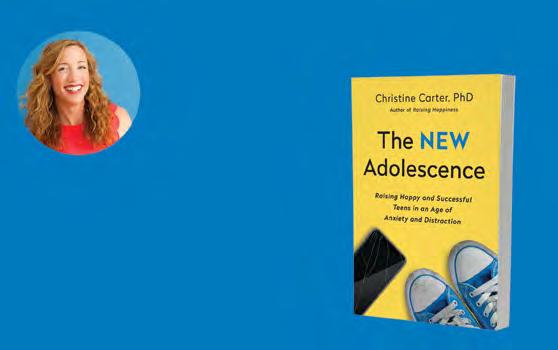
R aising Happy and Successful Teens in an Age of Anxiet y and Distrac tion
PARENTMAP / JANUARY 2023 / 53
“It is not too late for us. But we will not free ourselves of our addiction to locking each other up until we learn to stop locking each other out.”
How Breast Milk and Formula Impact Baby Teeth

Preventive steps to keep your family’s smallest smiles healthy
Primary teeth come in when babies are about 6 months old. However, parents can get a jump on their little one’s oral health before their first teeth even pop up.
For babies, the bacteria in their mouths feed on the sugar and carbs found in breast milk and formula. The bacteria create an acid that wears away tooth enamel. When breast milk or formula stays in a baby’s mouth for too long, over time, this acid can lead to cavities and tooth decay. These tips can make a big difference for your baby’s health over the long term:
• Feeding and teething items, such as bottles, pacifiers and toys, are best used when cleaned and sterilized. Cavity-causing bacteria can be passed from caregiver to child through saliva. Avoid sharing utensils and don’t test the temperature of a bottle with your mouth to avoid transmitting bacteria from your own mouth to your baby’s.
• Don’t put your child to bed with a bottle of breast milk or formula. When your child sips on breast milk or formula throughout the night, the sugars stay in their mouth, exposing their teeth to long periods of acid buildup from their mouth bacteria.
• Once a baby tooth comes in, begin your baby’s brushing routine by brushing with a soft-bristled toothbrush with a smear of fluoride toothpaste until age 2, and then a pea-size dot of toothpaste after age 2.
• Take your baby to a dentist by their first birthday to spot early dental health problems and to get your child used to visiting the dentist.
Breastfeeding, also known as chestfeeding, can help with baby’s oral health as well as their overall health. Several studies found that babies who were breastfed only for their first six months had fewer teeth alignment issues in comparison with those who breastfed for less time or didn’t breastfeed at all.
Another healthy option is bottle feeding. However, it is important
that children eat in one feeding. Don’t leave children with bottles for extended periods of time, as this can feed bacteria that create cavity-causing acid.
Formula comes in three different types in the United States, each with varying levels of fluoride, a natural mineral extremely important in maintaining a healthy smile. Fluoride strengthens and protects teeth, but too much fluoride can cause dental fluorosis — changing the tooth enamel and appearing as faint white streaks on the teeth.
The American Dental Association recommends that if liquid concentrate or powdered infant formula is the primary source of nutrition, it be mixed with water that is fluoride-free or contains low levels of fluoride to reduce the risk of fluorosis.
Consult your pediatric dentist or medical care provider if you have questions or to help determine the right amount of fluoride for your child and what formula will work best for your needs.
Delta Dental of Washington is the state’s leading dental benefit provider, covering nearly 3 million people in Washington state and nationally.
Wellness LOCAL RESOURCES / PEDIATRIC DENTISTS ■ 54 / PARENTMAP.COM
Healthy Smiles are Happy Smiles!


At Redmond Kids’ Dentistry, we treat each family like our extended family. We help each child achieve optimal oral health in a caring and safe environment. From age 1 to 18, our team helps guide you and your child through their developmental stages, starting from your baby’s rst tooth.


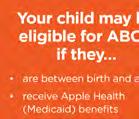


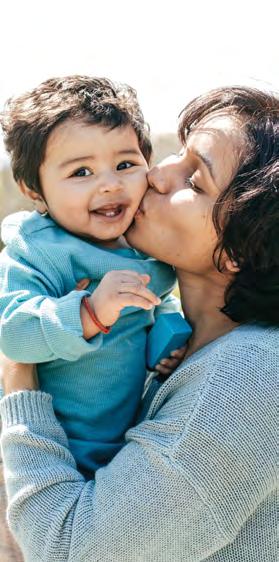



say their biggest reward is in all the smiles they see. We look forward to meeting you!




redmondkidsdentistry.com • 425-558-4562
Top Dentists
0821_Redmond Kids Dentistry 1-4.indd 1 7/6/21 5:25 PM LOCAL RESOURCES / PEDIATRIC DENTISTS Give your child’s teeth a healthy start. 1-800-756-5437 0123_ACCESS Baby and Child Dentistry 1-2v.indd 1 12/5/22 5:00 PM PARENTMAP / JANUARY 2023 / 55
Dr. Stephanie Su and Dr. Purva Merchant

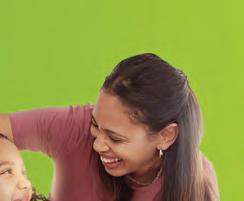




Free and low costApple Health and Marketplace insurance to fit your family’s needs. ChooseCoordinatedCare.com

























 By JiaYing Grygiel
By JiaYing Grygiel
















 By Patty Lindley
By Patty Lindley







 By Lauren Braden
By Lauren Braden




















































































































 M.D., section chief of Breast Imaging and Intervention at the University of Wisconsin School of Medicine and Public Health.
M.D., section chief of Breast Imaging and Intervention at the University of Wisconsin School of Medicine and Public Health.



















 By Mark Jones, Ph.D., and Rabbi Jay Rosenbaum
By Mark Jones, Ph.D., and Rabbi Jay Rosenbaum





















